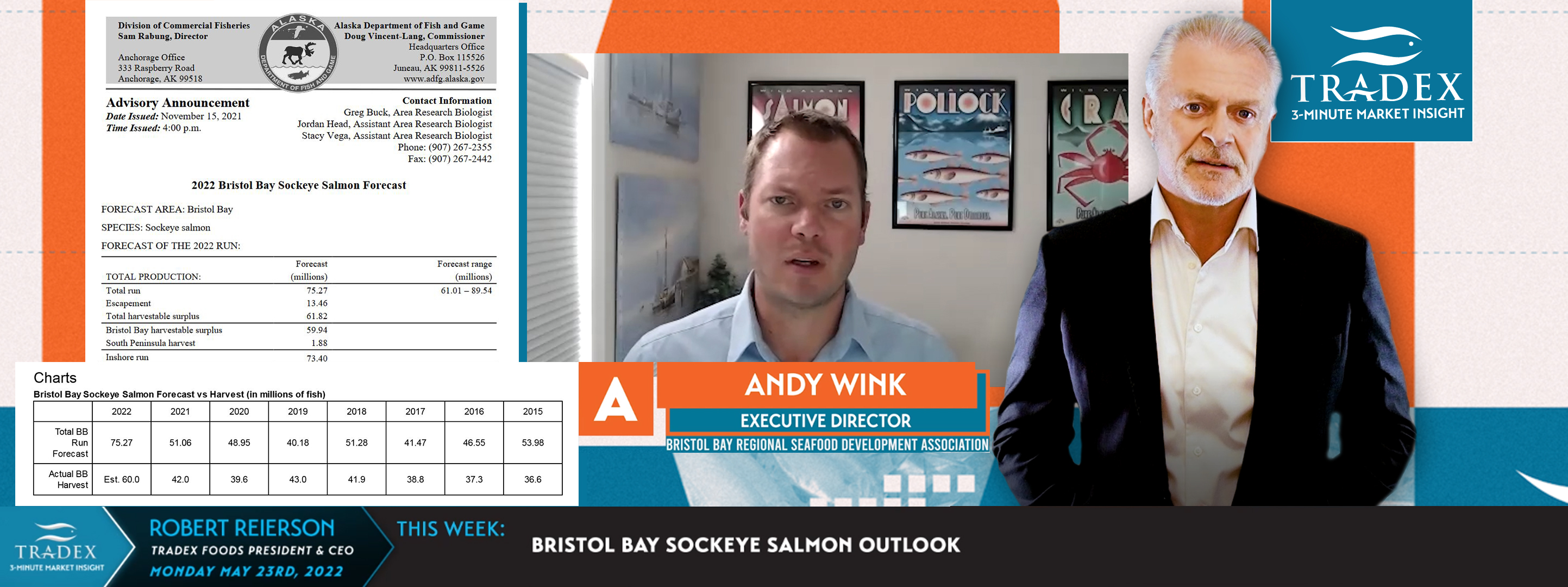
Loading
EP 590 | AIRED 05/23/2022
Bristol Bay Sockeye Salmon Market Outlook - 50 Million Bristol Bay Harvest, Buyer Beware on Volume & Quality
May 23rd, 2022 - Just as promised, this week we provide an exclusive Bristol Bay Sockeye report as we are joined by Executive Director (Andy Wink) of the Bristol Bay Regional Seafood Development Association, and then we also provide our market outlook on the upcoming Sockeye Salmon season.
--- On the line with us now from Bristol Bay Alaska is Andy Wink, Executive Director of the BBRSDA, where we ask him a few questions on the upcoming Bristol Bay Sockeye season.
[Robert] Hey Andy, thanks for joining us here.
[Robert] With Bristol Bay anticipating its largest Sockeye run of over 75 million fish, can you comment on what the Forecast vs Reality might look like as this would mean Bristol Bay would potentially process up to 60 million Sockeye this season - and could you also speak a little bit on the fish size as well.
[Andy] So the forecast suggests we might be looking at a substantial increase in supply for Alaska Sockeye this year. It will honestly be almost impossible to realize the harvest forecast of 60 million fish. Bristol bay has never eclipsed a 45 million fish harvest. And while we expect there is some room to grow that this year, it's probably more likely that the base harvest comes in between 40 to 50 million fish. We are expecting a high percentage of younger age classes in this year's run again. So it's likely you will see the average fish size remain small. Unfortunately fish size is something that is really in mother nature hands, but smaller fish size works great for steaks as it cooks faster and the fillet size tends to be about the right size for two people.
[Robert] With inflation and rising cost, can you speak to some of the ways these economic factors will affect Alaska's Salmon season this year.

[Andy] Alaska salmon industry is facing a lot of inflationary challenges like a lot of other economic sectors. Labor is more expensive and harder to find. Shipping and fuel costs are way up. Although fuel costs generally hit lower volume fisheries worse than high volume fisheries - and even borrowing costs are going up. However, these are wild fisheries, and we don't have to contend with rising feed costs like salmon farmers do. So, all in all, there's simply more costs that must be passed along throughout the supply chain.
[Robert] There seems to be some really great things coming out of the BBRSDA - such as the BBRSDA Marketing Program. Can you provide a little info on what this is for our viewers.
[Andy] So our Bristol bay Sockeye marketing program has matured a lot since we launched in several years ago. And although we've done promotions in over 3000 retail stores across the U.S. and Canada, many in the industry may not be aware of everything that we have to offer. So for those selling Bristol Bay Sockeye, we can fund in-store retail promotions that are supported by digital and social media marketing. Plus we have an ever-growing media library of assets with recipes, videos, fishermen, profiles, photos, cooking tips, and a whole lot more. So I'd encourage anyone looking to sell Bristol Bay Sockeye to check out our website, www.marketing.bristolbaysockeye.org and you can learn more about how we can help.

[Robert] Alaska is often taken as synonymous with sustainability. Can you share some thoughts or information on Alaska's carbon footprint.
[Andy] So Alaska Sockeye salmon often has a lower carbon footprint than people might expect. People probably often think of farm seafood or especially plant-based proteins as being better for the environment. But the reality is that the feed and the raw materials for those foods take up a lot of freshwater and require huge amounts of energy to produce. Plus farm salmon are usually shipped via plane around the world, and that creates a really high amount of carbon emissions per pound. So in contrast, wild Bristol Bay Sockeye are usually frozen near the point of harvest shipped around the world, via barge or truck in bulk, and they require no freshwater or human made feedstocks to grow.

Based on the results from a forthcoming study by the University of Washington, they found that a Sockeye salmon burger actually has about half the carbon footprint of a plant-based.
[Robert] Thanks Andy. I hope Bristol Bay and the fishing industry all over the state of Alaska have a safe and successful season.
[Andy] Thanks for having me on Rob.
--- Moving onto the market segment and at present, the market continues to be short on Sockeye.

Current pricing may however actually be higher than what the market is willing to pay as we are not seeing much sales activity for Sockeye at these higher price levels even with the low number of offers in the marketplace.
As for the Outlook...
In talking to processors, they are thinking the price of Sockeye will come out of the gates just as they left off - which was high.
We are also anticipating small fish again this year which typically results in lower yields, but could also lower the wholesale price as there will be a predicted surplus.

Advertise Here: advertising@tradexfoods.com
In my opinion, Sockeye fillets are getting too pricey for the consumer.
Rumor has it that there is an oversupply of last year's fillets that will be dumped into the market soon.
Japan will be a power to watch this year as they will not be buying Russian Sockeye and will be aggressive in securing new-season Alaska Sockeye.
With that said, Russian Sockeye is going to be a problem for Russian processors this year as very little typically goes to China and the USA will absorb none.
Russian Sockeye goes to Korea and Japan and both countries will not be purchasing from Russia for the foreseeable future.

Our Recommendation on the Sockeye Salmon market is to have a "buyer beware" mindset on how much volume you purchase, and to also perform your due diligence on quality this year.
We are still trying to get our pulse on how much 2021 supply still remains in freezers and if there ends up being some overstock, this could mean cheaper, but older product to hit the market.
Keep tuned-in to upcoming episodes as we continue providing a pulse report on the Summer Salmon Season.
--- If you are not already, be sure to subscribe to our 3-Minute Market Insight using the signup form below to keep tuned-in to all upcoming market insights.


